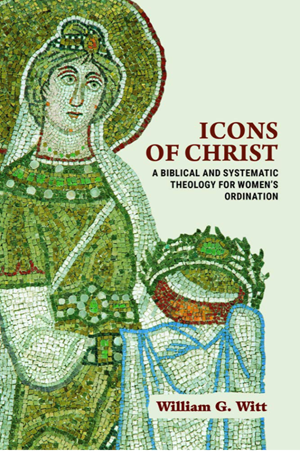Women's Ordination Begins in Genesis 1-3

The ordination of women is not mentioned, of course, in Genesis or the Old Testament. But the issues about the ordination of women begin there, and a good example of this is in the complementarian reading of Genesis 1-3 as found in Wayne Grudem.
William Witt’s fifth chapter in Icons of Christ, “Beginning with Genesis,” offers a brief exposition of salient factors in Genesis 1-3 and then states and responds to Grudem’s reading of Genesis 1-3.
He’s right: the creation account is used by both sides of this debate, one side for equality and mutuality and the other side for hierarchy and subordination. Which is more consistent with the text?
For similar reasons, the doctrine of creation is important for assessing concerns about women's ordination. The interpretation of Genesis 1-3 has played a major role in the discussion of women’s place, not only in marriage, but in the church and culture as well. The crucial question has to do with the interpretation of Genesis 3:16b: “Your desire shall be for your husband, and he shall rule over you.” Is this verse a command, a curse, or a description? Is it a command that is a furthering of a subordination that was nonetheless part of God’s intention in creation, or rather a punishment or curse in response to sin, or neither part of God’s intention for creation or a curse, but simply a description of the way things are in a fallen world, and thus a departure from God’s intention in creation? To be specific, if human beings had never sinned, would women be subordinate to men? Moreover, even if subordination is only a consequence of the fall, is that subordination something willed by God or something to be overcome as much as possible?
Witt’s questions are profound and must be answered no matter one’s viewpoint. Yes, Gen 3:16 is the big one and whether it is a prescription or a description determines what one sees here.
Witt turns to Genesis 1 and contends the text is about mutuality and equality and not about hierarchy and subordination. Big for Witt, as it should be, is that “adamah” (earthling, human) does not mean “Adam” as the first male but “human being” in general. This human is split in a sense in order to find two humans who are both called to the mission of being the image of God or what I like to call Eikons of God.
Nothing indicates hierarchy or subordination. Everything indicates equality.
In short, Genesis 1 describes man and woman as created equally in the image of God, and equally given a responsibility by God to exercise stewardship over creation. There is nothing in the passage to imply any gender-specific roles or any hierarchy of unequal relationships of authority between the two.
Genesis 2, a different creation account, is the first to indicate sexuality: when we get the woman, we get the man. We now have two sexes. The “ezer kenegdo” is one who is called not as a subordinate helper but as a companion helper. The first human is from the earth, the second from the other human. Then we get ish and ishah, man and woman.
Importantly, he does not “name” the woman but “calls” the woman, and what he calls is a “cry of recognition” that he now has a companion who is like the human. They are now man and woman.
The woman does not “cling to” the man but the man “clings to” the woman.
They are one flesh, which is as much a unity and equality as you can find. There is here no hierarchy.
Genesis 3 is the problem: it ruins the equality and unity. The words to the man and to the woman, to Adam and Eve, are not curses.
The themes of equality, mutual harmony, and companionship were introduced in Genesis 2 to prepare for what follows in Genesis 3, where the introduction of sin disrupts the original harmony of creation, and, as it were, turns everything upside down. Where there was mutuality, cooperation, and the fruitfulness of a garden, there now comes to exist competition, distrust, and conflict between the man and the woman, subordination of the woman to the man, and the struggle of both to survive a world that now produces thorns.
Broken relations between human beings means that the harmonious “one flesh” relationship intended by God for men and women in marriage is disrupted as women yearn for the restoration of an original harmony that no longer exists, and men forget the original purpose of woman as a “suitable companion,” and instead tend rather to “rule over” women. The end result is dysfunctional relationships for both men and women.

After this brief exposition, Witt turns to seven of Grudem’s well-known theses about Genesis 1-3, theses that build his case for a complementarian hierarchy and subordination.
The Order: Adam Was Created First, Then Eve The Representation: Adam, Not Eve, Had a Special Role in Representing the Human Race The Naming of Woman: Adam Names Eve The Naming of the Human Race: God Named the Human Race “Man,” Not ' Not "Woman” The Primary Accountability: God Spoke to Adam First after the Fall The Purpose: Eve Was Created as a Helper for Adam, Not Adam as a Helper for Eve The Conflict: The Curse Brought a Distortion of Previous Roles, not the Introduction of New Roles
To each Witt responds. He is not harsh or unfair in saying there is too much misreading by Grudem and even imposing back on Genesis 1-2 what Grudem thinks is prescriptive in Genesis 3:16.
It is one of the firm conclusions of many, esp of the more mutualist view, is that Genesis 3:16’s “... your desire shall be for your husband, and he shall rule over you” is a description of fallen state and not divine design. It is a breakdown. It is not God’s plan.
The issue then is this: Does the redemption in Christ lead, as “redemptive” themes have cut back on the pain in childbirth and the pain in farming, to undoing the themes of desire and rule?
NEXT POST: Why were the disciples of Jesus all men?
Jesus Creed is a part of CT's
Blog Forum. Support the work of CT.
Subscribe and get one year free.
The views of the blogger do not necessarily reflect those of Christianity Today.




















